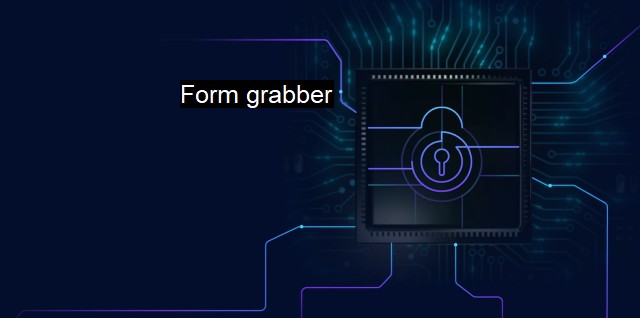What is Form grabber?
The Dangers of Form Grabbers: Eavesdropping on Sensitive Online Data Transmission
Form grabber is a type of malware, explicitly designed to capture and exfiltrate data submitted through web forms, typically those found on login pages or checkout pages on e-commerce sites. In some contexts, it is often referred to as "FormGrabber," named after one of the popular form grabber malware. In the ambit of cybersecurity and antivirus solutions, understanding and guarding against form grabbers is essential.Form grabbers function by infiltrating a computer's browser, often through a trojan or another malicious software delivered to the victim's computer via a phishing link or direct file download. Once activated, the malware remains dormant until the user opens a web browser and enters information into a web form. The malware grabs the information at the moment it is submitted, catching usernames, passwords, credit card information, and other sensitive user information straight from the user's inputs.
Form grabbers work after exploit systems or security laxities to install themselves on the victim's computer. They work by injecting themselves as a malevolent code into web browsers and oversee everything the browser does. When a web form is filled, form grabbers collect the form's data just before it is encrypted for transmission. It captures raw data of web form inputs, so anything a user types into a form is vulnerable, including sensitive data such as Social Security numbers, banking numbers, card details, and passwords.
Form grabber malware is highly invasive and difficult to discern because it doesn't alter the system's functionality. Instead, it silently siphons off information, sending the collected information back to the cybercriminal over the internet. This method of attack is often very successful, as the malware is undetectable due to its covert operation until after data theft has been carried out, and is also challenging to remove.
Understanding form grabbers is critical in the areas of cybersecurity and antivirus software development. Since form grabbers constitute a significant part of cybercriminal arsenals, antivirus programs need to keep up with evolving strategies and techniques used by these hackers. Unfortunately, traditional antivirus solutions might not adequately tackle form grabbers due to their stealthy and invasive nature.
Antivirus software generally protects against known threats by detecting and removing them. this protection might not work effectively against form grabbing malware that easily camouflages within the user's browser. In reaction to this, some antivirus solutions leverage behavioral-based detection methods that evaluate the behavior of software applications and network connections; if they notice a program act suspicious in scanning and scrutinizing web forms, the antivirus solution takes appropriate defensive action.
In the cybersecurity field, professionals are deploying considerable preventive measures, aside from antivirus software. Notably, they recommend users to avoid untrusted downloads, regularly update their systems, use software with sandboxing capabilites which essentially isolate potential hazardous applications from causing harm, and practice overall good internet hygiene.
Companies dealing with sensitive customer data must also prioritize secure coding practices to mitigate the susceptibility to form grabbers. Having stringent security policies, carrying out regular auditing and diligent threat hunting, as well as training employees in security awareness, can help companies ensure they are doing everything possible to avert form grabbing attacks.
Meanwhile, consumers are advised to perform safe online practices. These include maintaining regular system updates, not clicking suspicious links, checking for secure website connections (HTTPS), and regularly changing passwords. Also, using multi-factor authentication can provide an additional layer of security.
While form grabbers continue to be a persistent presence in the ever-evolving cyber threat landscape, understanding their operation and adopting robust cybersecurity measures can serve to substantially reduce their threat. As hackers continue to refine their tactics, the field of cybersecurity must keep pace to appropriately address these formidable risks.

Form grabber FAQs
What is a form grabber?
A form grabber is a type of malware that steals the information entered into web forms on infected computers.How does a form grabber work?
A form grabber works by intercepting and recording the data entered into web forms, such as login credentials or credit card numbers, before it is encrypted and sent to the server. The malware then sends the stolen data to a remote server where it can be used for fraudulent purposes.How can I protect myself from form grabbers?
To protect yourself from form grabbers, you should use a reputable antivirus software and keep it up-to-date. You should also be cautious when entering sensitive information online, and ensure that the website you are using has a valid SSL certificate. Additionally, you can use a virtual keyboard to enter sensitive information, which can help prevent keylogging attacks.What are the potential consequences of a form grabber infection?
The potential consequences of a form grabber infection can be serious, as it can lead to identity theft, financial fraud, and other types of cybercrime. If your personal or financial information is stolen, it can be used to open fraudulent accounts, make unauthorized purchases, or even commit crimes in your name. Your credit score and reputation may also be negatively impacted by a form grabber attack.| | A | | | B | | | C | | | D | | | E | | | F | | | G | | | H | | | I | | | J | | | K | | | L | | | M | |
| | N | | | O | | | P | | | Q | | | R | | | S | | | T | | | U | | | V | | | W | | | X | | | Y | | | Z | |
| | 1 | | | 2 | | | 3 | | | 4 | | | 7 | | | 8 | | |||||||